Menu
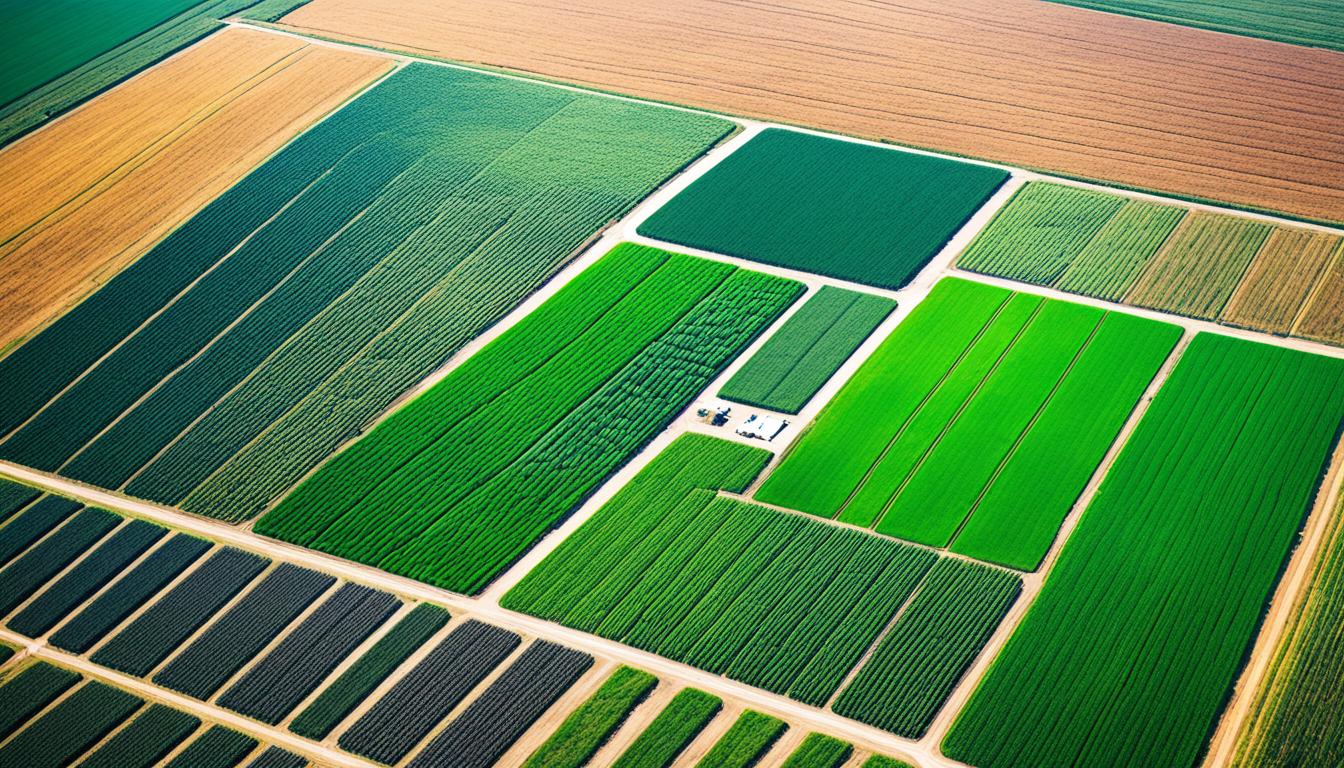
In 2012, 88% of corn, 94% of cotton, and 93% of soybeans in the United States came from biotech plants. These numbers show just how important biotech has become in farming. It meets the world’s big need for more food.
Biotech’s use in farming is key because the world has more people and they want better food. Our farms have to work harder than ever. Biotechnology helps make farming better for the planet and more efficient.
Technology like genetic engineering and using microbes is making crops healthier and farms stronger. The future of farming looks bright, thanks to these modern tools. They are changing farming for the better, with a focus on growth and sustainability.
Agricultural biotechnology is changing farming in many ways, solving tough problems. It has changed how we grow crops and manage farms. These new methods are making farming more efficient and productive.
In 1986, the U.S. Department of Agriculture created rules for biotech in farming. This boosted the testing of new crops and their quick launch. The United States saw big biotech progress because of these rules, while Europe faced more limits. Tough rules in Europe made companies move to the U.S. for research.
The United States is a top player in modern biotech, showing what’s possible. In 2012, most corn, cotton, and soybeans grown were biotech. These crops help reduce pesticide use, control pests better, and manage weeds. They let farmers use safer herbicides that aren’t harmful to people or wildlife.
The future of agricultural biotech looks bright, with more growth and innovation ahead. Setting smart regulations that keep up with science is key. These rules should make sure new biotech is safe. They also play a big part in helping crops grow better, making farming easier.
One example is making rice with more beta-carotene to fight vitamin A lack. This shows how biotech can help with health too. Agencies like the USDA, EPA, and FDA work together to keep food and the environment safe. They help make sure biotech in agriculture is both groundbreaking and secure.
Genetic engineering in farming has brought in a new chapter. It has made farming more productive and sustainable. This technology addresses many environmental and economic hurdles. It does so through its genetically modified crops. In this context, we will explore the benefits and the ethical side of genetic engineering in agriculture.
Genetically modified crops have changed the face of farming. They offer answers to the common issues of agriculture. For example, corn, cotton, and soybeans in the US saw significant biotech usage in 2012. These crops are made tough against pests and diseases. As a result, less chemical pesticides are needed. This improves crop yield all round.
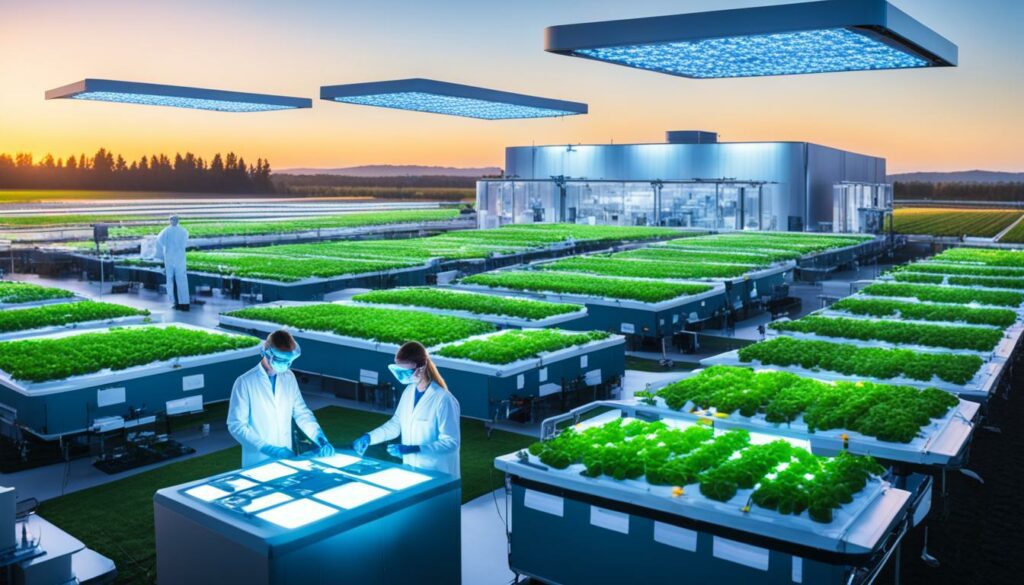
The world is seeing more biotech crops as regions catch on to their potential. Important bodies like the USDA, EPA, and FDA make sure these crops are safe. They check them thoroughly to protect consumers and the environment.
The gains from using genetic engineering in farming are vast. Firstly, these crops can make the quality of our food better. This, in turn, boosts farm profit. Herbicide-tolerant GM crops have also cut down on herbicide use by 8%-20%. This brings huge environmental pluses like less greenhouse gases and better soil. GM crops also make controlling pests, weeds, and fighting diseases easier. This helps farmers work safer.
| Crop | Percentage of Total Plantings in the U.S. (2012) |
|---|---|
| Corn | 88% |
| Cotton | 94% |
| Soybeans | 93% |
In Canada, over 100 GM foods have been okayed since 1994. This shows their broad acceptance. Foods like apples, canola, and corn are common. Canola, soybeans, and corn are nearly all the GM plants in Canada. The benefits of genetic engineering are clear in farming’s success and efficiency.
While there are many pros of genetic engineering in farming, ethical issues are important to think about. People continue to worry about food safety and the environment. They also debate the moral side of changing natural life. Balancing innovation with ethics is key. It involves following strong rules and keeping up with science.
Organisations like the FAO and WHO say GM crops are safe for people and animals. But, the ethical debate goes on. It calls for a thoughtful and science-focused way of using genetic engineering in farming.
Microbial applications in farming are changing how we grow food. They’re enhancing soil health and helping control pests naturally. By 2027, the market for these tiny organisms could be worth USD 12 billion. Their role in agriculture is becoming more and more important.
Enhancing soil health with microbes has become very popular. Good bacteria and fungi make the soil better for plants. They help with nutrient availability and water storage. This makes crops grow better and helps them fight off stress. China, India, the USA, and Germany are leading in this area. They’ve published a lot on how these tiny organisms can help grow food better.
Microbes are also key in keeping pests at bay. They can fight specific pests without using harmful chemicals. The European Union wants to reduce N-fertilizer and pesticide use. This puts even more focus on microbial solutions. Big companies like BASF SE and Bayer are coming up with new ways to control pests the natural way. This keeps the environment healthy and farming sustainable in the long run.
Many new companies are getting into making these microbial products. From 2015 to 2020, there’s been a big spike in research about them. It shows farming with microbes is an ever-growing field. As more big players get involved, the future of farming looks promising. But, there’s a need for clear rules to keep things in check and help these methods grow.
Agricultural biotechnology is making big changes in how we protect crops and improve livestock. Innovations in these areas are key for the new ways agriculture is growing.
Bioengineering is transforming crop protection. In 2012, 88% of corn, and 94% of cotton, along with soybeans at 93%, were genetically modified in the United States. These changes have improved fighting off insects and weeds. They’ve made farming more profitable and less dependent on traditional pesticides.
These advancements include crops that can resist pests, even in tough conditions. This is important for farming that needs to adapt to changing climates and remain sustainable.
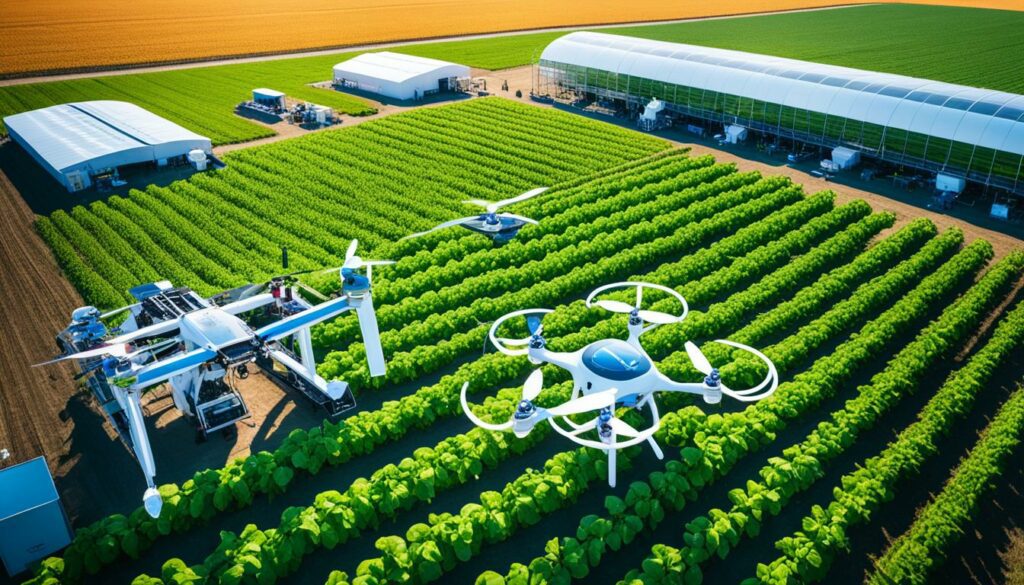
The livestock industry is also seeing big improvements thanks to agricultural biotech. Animals are now genetically modified to fight diseases better. This has led to less dying animals and more productivity on farms. For example, cows have been modified to produce more milk efficiently through CRISPR gene editing.
A new method using microbes is revolutionising how we produce antibiotics for livestock. Now, with this technology, we can have healthier animals without overusing traditional drugs. This is a big step towards farming that is better for the environment and more affordable.
The combination of better crop protection and livestock technology is changing farming. These advancements help agriculture adapt to challenges in our environment and economy. They are crucial for making farming sustainable and strong.
| Crop | Percentage of Biotechnology Plantings (2012) | Key Benefits |
|---|---|---|
| Corn | 88% | Enhanced insect pest control, reduced pesticide use, increased yields |
| Cotton | 94% | Weed management, reduced environmental impact, higher profitability |
| Soybeans | 93% | Pest resistance, improved soil quality, sustainable farming |
Biotech crops are key in the fight for a greener planet. They lower our reliance on harmful pesticides and make our soil better. These crops are designed to survive tough conditions, needing less water. This makes them better for the planet and us.
These special crops also mean we can use fewer chemicals. This helps our environment by not just protecting our crops but also the animals that live around them. It’s a win for everyone!
Insect-resistant cotton and other similar crops have cut down the need for pesticides a lot. This not only keeps us and the wildlife safer but also reduces harmful gases in the air. In 2018 alone, the U.S. farming sector accounted for 10.5% of these gases. Because of these crops, though, our farming is becoming more nature-friendly.
BioTech in Costa Rica is at the forefront of making our soil better. They are using tiny fungi and bacteria to fight off plant diseases. This not only makes our crops healthier but also our soil. For example, using Trichoderma spp. in pineapple farms has boosted their yield by up to 12%.
The link between biotech and a healthier environment is clear. With advancing technology, we are on track to farm in ways that help our planet thrive. The future promises even better farming for both our food and the Earth.
Biotech has changed farming, making it more modernised. It tackles the issues brought by a growing world and uncertain weather. Thanks to genetic engineering and using microbes, we see farming become more stable and work better.
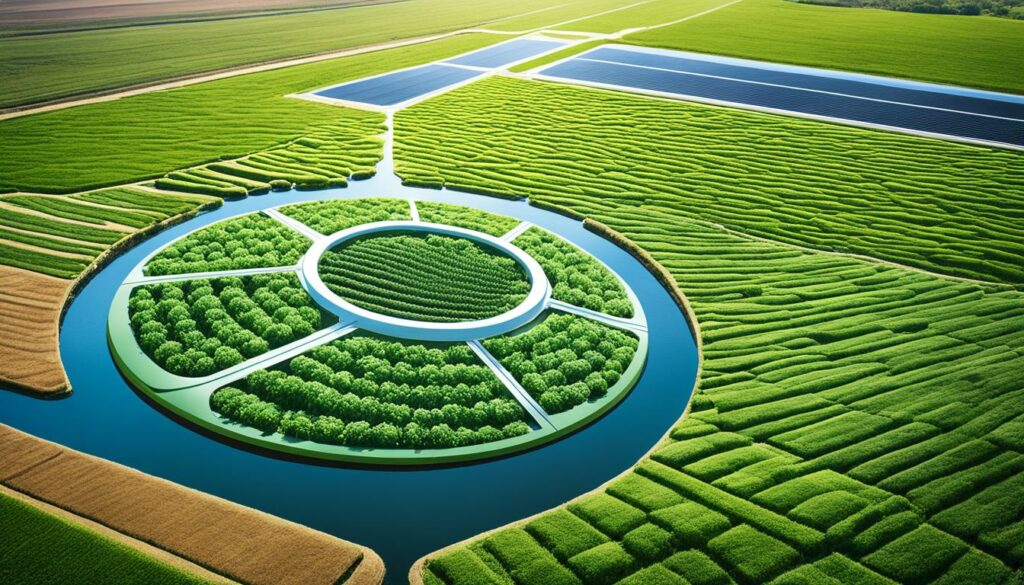
The main aim in using biotech in farming is to increase how much we grow. In 2012, over 88% of corn, 94% of cotton, and 93% of soybeans in the US were biotech. This technology helps farmers grow more food in an easier and safer way.
| Crop Type | Percentage of Biotech Plantings (2012) |
|---|---|
| Corn | 88% |
| Cotton | 94% |
| Soybean | 93% |
Biotech makes farming more resilient to climate change. It helps crops survive more droughts and floods. For example, some crops can survive with less water. This helps keep farms productive even in tough times.
The International Service for the Acquisition of Agri-biotech Applications (ISAAA) says biotech is key for food security. Using less chemicals, this technology supports both sustainable farming and higher yields.
Biotech allows farming to cope with changing climates and still produce. It shows how important and effective biotech is for a better, safer future in farming.
Solving the world’s food challenge without harming the environment is key. Ag Biotech started in 1992, focusing on green farming. They work in more than 20 countries, showing their dedication to eco-friendly agriculture.
In Vietnam, Bio Shot by Ag Biotech boosted rice yields by 25%. In East Africa, their biofertilizers made maize crops increase by up to 30%. They work closely with farmers to meet local needs with their sustainable methods.
Ag Biotech’s methods reduce the need for harmful chemicals. Their products help crops grow more and protect the planet. This leads to less waste and better use of resources, helping against climate change and in dry areas.
Ag Biotech also helps protect our planet’s important lands. Their approach helps with biodiversity and keeps the climate stable. They work with many groups worldwide to push for sustainable farming.
Crops like maize, rice, wheat, and soybean are growing every year, but not fast enough. We need a bigger increase to keep up with the growing population and changes in the climate. Biotechnology is key in making sure there is enough food in the future, in a way that doesn’t harm the planet.
The United States leads the world in agricultural biotechnology. It achieved this through forward-thinking government biotech policies and strong support for biotech research and development. This leadership was solidified in 1986 with the adoption of the “Coordinated Framework for the Regulation of Biotechnology.” This framework sped up the development and release of new biotech plant types.

The U.S. became a biotech leader thanks to smart policy choices. The U.S. Department of Agriculture (USDA) set out the first rules for better crops. This move helped more crops get tested and used. In Europe, rules from 1990 lagged behind, focusing on DNA methods rather than crop benefits.
The U.S. Environmental Protection Agency was slower with tips on new tiny life forms, like microbes. This delay made it hard for new ideas to turn into real products. But, the Food and Drug Administration (FDA) quickly made safety rules for foods from biotech crops. This fast response helped these foods get accepted in the market.
The U.S. keeps ahead in agricultural biotech by investing in biotech research and development. This support led to some amazing progress. For example, Dr. Hank Harris and his team at Harrisvaccines created key vaccines for pigs. These vaccines helped handle diseases such as H1N1.
The U.S. Secretary of Agriculture, Sonny Perdue, also made an important plant biotech rule change recently. This rule aims to make the process of approving new crops simpler. It focuses on new science, working to boost agriculture, protect the environment, and make food safer. These actions show how the U.S. government is involved and ready in this key industry.
European policies for biotech make it hard for companies to grow. They care more about how biotech is made, not what it does. This focus slows down testing and new ideas. Because of this, many businesses move to the U.S. where rules are easier.
In Europe, there’s a careful view on biotech. This comes from paying extra attention to DNA tech and listening to certain groups. Because of these tough rules, progress in biotech in Europe lags behind others.
Despite the tough rules, the EU knows how important biotech is. From 2008 to 2018, the sector’s growth was impressive, more than the whole economy. It added a lot to the GDP and created many direct jobs, benefitting healthcare, industry, and farming.
There are chances for European countries. They can work with their rules better and support biotech. Europe has a lot of renewable materials. This can help grow the industry.
So, European biotech rules have both good and bad sides. By making the rules clearer and simpler, Europe can do much better in the biotech world. To understand more about these rules, look at the official guidelines.
| Region | Market Share (%) | Contribution to GDP (EUR billion) | Annual Growth Rate (%) |
|---|---|---|---|
| United States | 60 | Not specified | 18 |
| European Union | 12 | 31 (in 2018) | Growth rate more than twice the overall economy between 2008-2018 |
| China | 11 | Not specified | Not specified |
The world of farming is changing fast with futuristic biotech agriculture leading the way. Technology like gene editing, synthetic biology, and new biopharmaceuticals are turning the industry upside down. These tools promise to make our food safer and more nutritious, all while caring for our planet.
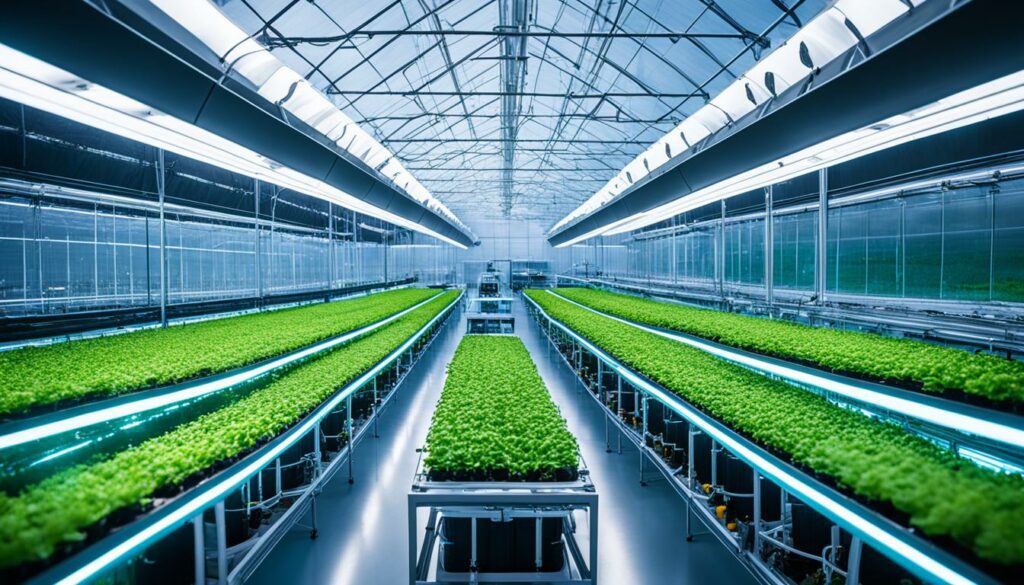
At the heart of this change are new tech tools. For example, CRISPR-Cas9 lets scientists edit plant genes very precisely. This has led to crops that can withstand droughts better and give more food. Then you have synthetic biology, which is making it possible to design plants that do things they’ve never done before.
Plants are being used to make special medicines too. This is a big step in finding new ways to fight and prevent diseases.
The chance for farming to grow with these new technologies is big. In 2012, nearly all corn, cotton, and soy in the U.S. came from biotech plants. This shows how the U.S. is a leader in using technology in farming. Hard work in making good rules began back in 1986. To keep leading, we need to always improve our technology and our rules.
Looking ahead, these new agricultural technologies will help solve big farming problems. They will also shape the path for farming in the future, making sure we can always grow enough food for everyone.
It’s clear that biotech changes in farming have caused a big economic shift. The U.S. started with the 1986 “Coordinated Framework for the Regulation of Biotechnology.” This led to more field tests and quicker use of biotech seed types. By 2012, nearly all corn and most cotton and soybeans in America were biotech crops. This lowered costs and made farming more profitable.
A look at costs and benefits in biotech shows big pluses. Biotech crops have cut down on the use of chemical pesticides, which is great for farmers and the planet. This saves money and helps farming stay green. Also, crops like soybeans, cotton, and corn that can deal with more herbicides make it possible to use kinds that break down quickly. This saves even more on costs and makes the soil healthier.
Market trends show we’re leaning more on biotech in farming. This is because of the improvements and how it boosts the economy. The USDA, EPA, and FDA check biotech foods very closely to make sure they’re safe. This makes people feel good about using them. The International Service for the Acquisition of Agri-biotech Applications (ISAAA) says more and more farmers are using biotech crops. This shows they’re here to stay and will keep growing. With rules getting better as we learn more, biotech keeps being good for business. This points to a strong financial future for the field.
It’s vital to know what consumers think about agri-biotech. This helps build more trust in new farming technologies. Surveys show people see this tech differently. Their views are shaped by worries about health, safety, and knowing how safe it is.

Many people are worried about the health and safety of biotech foods. Over half often check food labels. This shows they want to know if products use biotechnology. The USDA checks these foods carefully. It makes sure they are safe and don’t cause allergies or harm the environment. More than half of Americans like biotechnology. They believe rules should change to let new biotech products come to market quicker.
Teaching people about biotechnology is key to filling the knowledge gap. Only 44% understand what biotech really is. Teaching plans are crucial for making it clear. Around 80% of those who have learned more feel better about biotechnology. Good education can fight wrong ideas. It can help people make smart choices.
The data below shows the main survey answers:
| Aspect | Percentage |
|---|---|
| Response Rate | 41% |
| Awareness Level of Biotechnology | 44% |
| Use of Food Labels | 53% |
| Importance of Biotech Label Attributes | 58% |
| Favourable Opinion on Biotechnology | 62% |
| Support for Faster Commercialisation | 66% |
The agri-biotech awareness challenges and the strict biotech regulatory hurdles hold back the use of biotechnology in farming.
Not knowing enough about biotech is a big problem for many. This is very true in places still developing, where there are a lot of issues to deal with. These can be social problems, not having enough money, or even lack of roads and buildings. It makes using new farming technologies hard. Showing people how these technologies are good for growing more food and keeping food safe is important.
Some new farming methods help the poorest people by making food more nutritious. But, it’s hard for leaders to decide what to focus on because they don’t have much money. They also don’t always get the best advice.
Rules and laws are also a big challenge for biotech farming. These rules are sometimes hard to understand, and different countries have different ones. This can make it slow to start using new biotech methods. For example, the European Union has very strict safety and quality rules for food. But, in the U.S., agencies are more flexible and change their rules often. This helps keep up with new biotech.
The EU and others are trying to make their rules simpler. In Russia, there are many laws about food safety. Making these rules easier could help more places use new farming technologies.
Biotech is changing the way we farm, boosting efficiency and sustainability. Transgenic crops have been a success worldwide. They’re safe for our health and the environment. They haven’t caused harm to Monarch butterflies or made pests resistant to crop protection. These crops let farmers use less harmful pesticides.
Yet, we can’t ignore possible future risks. There have been some weed problems with herbicide-tolerant crops. But, “superweeds” haven’t taken over yet. Scientists are working to prevent these issues. Still, we need more research to be sure about the long-term effects of genetically modified crops. Our rules and checks must also get better to keep up with the risks.
Across the globe, agri-biotech is making big leaps. South Korea and Cuba are doing well in healthcare biotech. South Korea has climbed the ranks to the 12th position in health biotech since 2002. But, some countries like Brazil and India are behind due to education issues. Countries like Egypt and companies from India are making important medical products affordable. Biotech is also helping South Africa with its HIV/AIDS research. All these efforts show the big role and promise of biotech in farming.
Biotech is leading us from traditional farming to a new, more collaborative approach. It involves smart policies, lots of research, and ethics. The aim is a future where we have enough food, protect the environment, and can deal with climate change. This is possible through advanced biotech solutions. By working together, everyone can benefit from the changes biotech brings to farming.
Biotech innovation in agriculture uses advanced tools to boost crop growth and help crops resist stress. It’s about making farming sustainable to deal with food security and the changing climate. This includes using genetic engineering and helpful microbes.
In 1986, the USDA in the U.S. set up rules for testing and selling biotech crops. After making a start, Europe’s strict rules pushed businesses to the U.S. Europe lost out on early biotech efforts because of this.
Genetic engineering makes crops tough so they can survive pests and diseases. This leads to more food and less need for harmful chemicals. It helps farmers use better, safer ways to farm.
Microbial applications use helpful microbes to make soil healthier and fight pests naturally. These methods boost the soil’s fertility, stop pests from growing, and lower the need for chemicals. They help farms thrive in a natural, eco-friendly way.
Biotech crops lessen the use of harmful pesticides, which is great for the soil and wildlife. For example, insect-resistant cotton cuts down on pesticides a lot. This is good for both nature and people.
Now, we’re seeing more about genetic engineering, using microbiology, and making better livestock. The U.S. leads because they support growth and invest a lot in research. New technologies are coming fast and promise to change the industry a lot.
Sustainable solutions are key to making sure we have enough food, keep our surroundings safe, and fight climate change. Biotech helps by making farming friendly to nature, needing less, and keeping the balance. It’s all for a healthier, greener future.
The U.S. government is big in supporting biotech through its rules and support for new ideas. The Coordinated Framework by the USDA, EPA, and FDA hits the sweet spot in making sure biotech is safe and grows well.
Europe’s tough rules slow down progress in biotech. These strict steps make it hard to test new things and be creative. Many companies pick the U.S. for their research instead. But, Europe is working to make the rules friendlier to new ideas.
Going forward, we’ll see more of gene editing, making life from scratch (synthetic biology), and special plant drugs. These new methods can change how we get food, make it more nutritious, and clean up the planet. They are the future of farming.
Biotech makes farming more cost-effective and brings more earnings for farmers. More and more people are open to using biotech in farming. This means big chances for growth and showing how valuable biotech products are.
People have different views on biotech farming, often around health. Food made this way goes through tests to be sure it’s safe. Teaching more about biotech helps people make smart choices.
Not knowing enough and facing tough rules slows biotech down. Fixing this means sharing good info and making rules that work better. These changes can make more farms use new biotech ideas.